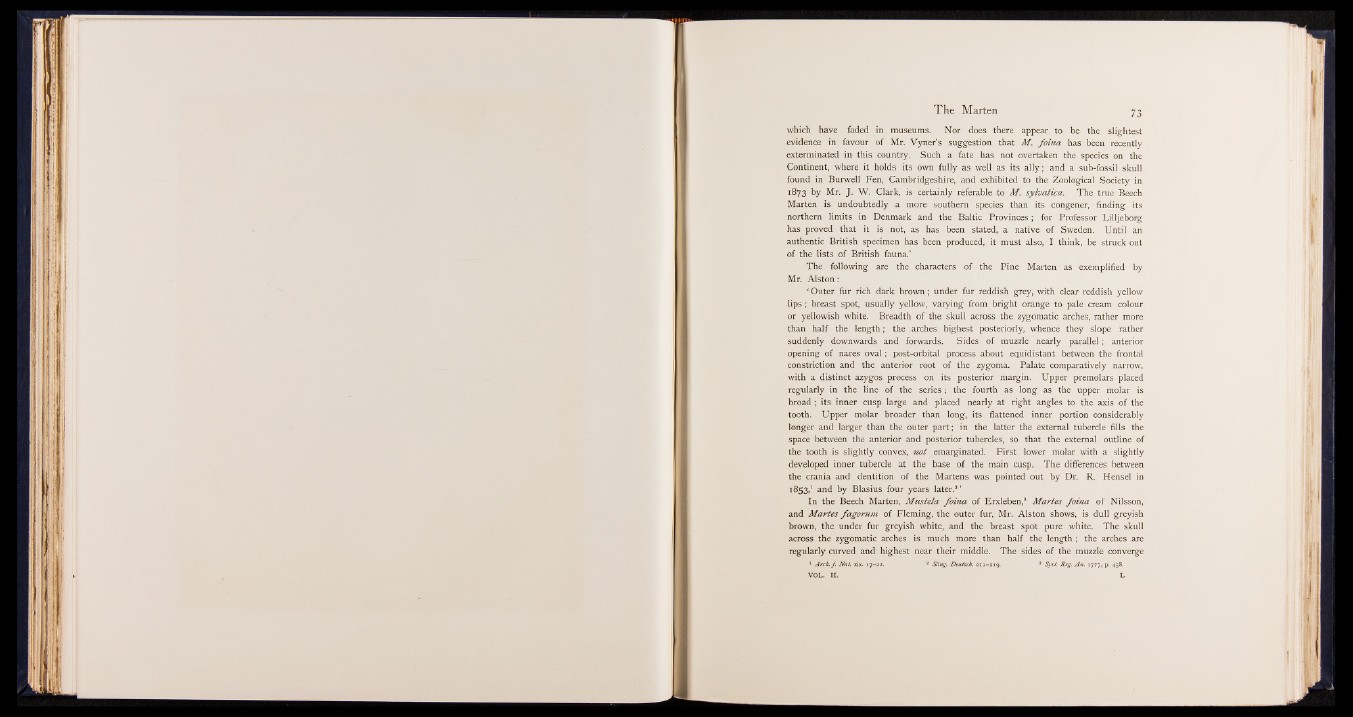
which have faded in museums. Nor does there appear to be the slightest
evidence in favour of Mr. Vyner’s suggestion that M . fo in a has been recently
exterminated in this country. Such a fate has not overtaken the species on the
Continent, where it holds its own fully as well as its a lly ; and a sub-fossil skulll
found in Burwell Fen, Cambridgeshire, and exhibited to the Zoological Society in
1873 by Mr. J . W. Clark, is certainly referable to M. sylvatica. The true Beech
Marten is undoubtedly a more southern species than its congener, finding its
northern limits in Denmark and the Baltic Provinces; for Professor Lilljeborg
has proved that it is not, as has been stated, a native of Sweden. Until an
authentic British specimen has been produced, it must also, I think, be struck out
of the lists of British fauna.’
The following are the characters of the Pine Marten as exemplified by
Mr. Alston:
‘ Outer fur rich dark brown; under fur reddish grey, with clear reddish yellow
lip s ; breast spot, usually yellow, varying from bright orange to pale cream colour
or yellowish white. Breadth of the skull across the zygomatic arches, rather more
than half the length; the arches highest posteriorly, whence they slope rather
suddenly downwards and forwards. Sides of muzzle nearly parallel; anterior
opening of nares o v al; post-orbital process about equidistant between the frontal
constriction and the anterior root of the zygoma. Palate comparatively narrow,
with a distinct azygos process on its posterior margin. Upper premolars placed
regularly in the line of the series; the fourth as long as the upper molar is
broad ; its inner cusp large and placed nearly at right angles to the axis of the
tooth. Upper molar broader than long, its flattened inner portion considerably
longer and larger than the outer part; in the latter the external tubercle fills the
space between the anterior and posterior tubercles, so that the external outline of
the tooth is slightly convex, not emarginated. First lower molar with a slightly
developed inner tubercle at the base of the main cusp. The differences between
the crania and dentition of the Martens was pointed out by Dr. R. Hensel in
1853/ and by Blasius four years later.3 ’
In the Beech Marten, M ustela fo in a of Erxleben,8 M artes fo in a of Nilsson,
and M artes fagorum of Fleming, the outer fur, Mr. Alston shows, is dull greyish
brown, the under fur greyish white, and the breast spot pure white. The skull|
across the zygomatic arches is much more than half the length ; the arches are
regularly curved and highest near their middle. The sides of the muzzle converge
1 Arch. f . Nat. xix. 17-22. 2 Säug. Deutsch. 211-219. 3 Syst, Reg. An. 1777, p. 458.
VOL. II. L